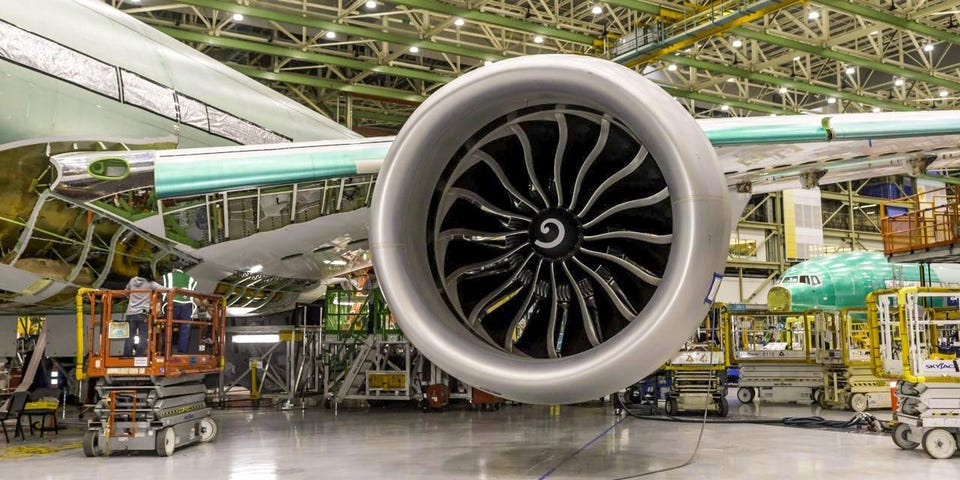Manufacturing Is 3D Printing The Sustainable Manufacturing Solution? Carolyn Schwaar Contributor Opinions expressed by Forbes Contributors are their own. I’m a journalist covering professional and industrial 3D printing. Following New! Follow this author to stay notified about their latest stories.
Got it! Sep 30, 2022, 08:31am EDT | New! Click on the conversation bubble to join the conversation Got it! Share to Facebook Share to Twitter Share to Linkedin The world’s largest jet engine, the GE9X developed by GE Aviation, has six 3D-printed parts inside . . .
[+] and boasts 12% lower fuel consumption and 10% lower operating costs than competing engines. Boeing 3D printing, or additive manufacturing (AM) as it is called in industrial applications, is gaining a foothold in factories and shop floors across the country. Compared to traditional manufacturing, it can be faster, cheaper, and more flexible, but how sustainable is it? Can it help companies like GE, Siemens, and Volkswagen — companies that have both adopted AM and pledged to lower their carbon footprint — achieve their sustainability goals? A new tool out this week from Ampower , an EU-based additive manufacturing think tank and consultancy, is designed to help companies measure the energy consumption and CO2 emission of metal 3D printing.
The company’s new Sustainability Calculator is a tool for manufacturers to input and compare various metal material choices and AM technology combinations to determine the resulting CO2 emissions. Customization options and overrides can account for choices made throughout a globally distributed process chain. “There is no general answer to which manufacturing technology has the lowest carbon footprint,” Ampower says in its new report Sustainability of Metal Additive Manufacturing , since the overall footprint is heavily influenced by the type of metal and the part geometry.
However, in comparing two like parts: 1,000 brackets designed to be milled vs. 1,000 similar brackets designed to be 3D printed, the calculator found that sand casting had the lowest CO2 emissions when the parts are made in aluminum. But change the material, and the equation shifts.
The same brackets traditionally milled in titanium result in CO2 levels twice as high as AM technologies, such as laser powder bed fusion and binder jetting . Comparing sustainability of AM and traditional manufacturing doesn’t end when the part is manufactured, many in the 3D printing industry argue. There’s a knock-on effect with additive manufactured parts that enables conservation far down the value chain.
Consider the brackets mentioned above, which are used for aerospace applications. MORE FOR YOU Germany’s Renk Group Seeks To Revitalize An Iconic American Defense Manufacturer What Drives Newly Minted CRISPR Unicorn Mammoth Biosciences A Million Parts Using 3D Printing? Mantle’s Printed Tooling Powers Mass Production With aircraft parts, the weight is often linked directly to fuel consumption and, therefore, CO2 emissions. 3D printing technology can create shapes not possible with other technology enabling parts that use less material and weigh less but are equal in strength.
AMpower’s example bracket designed for AM pictured below uses less material than the conventionally manufactured version. A comparison of aerospace brackets designed for milling (left) and additive manufacturing (right) . .
. [+] shows in-use CO2 savings for the additively manufactured version. AMpower “We hope that companies will use the tool to optimize their processes and parts toward low carbon footprint,” says Matthias Schmidt-Lehr, Ampower’s managing partner.
“Also, it should bring clarity regarding the question, where additive manufacturing can contribute to a lower footprint, and where traditional technologies are more efficient. ” According to Ampower, a 1-kg weight saving in a plane translates to an annual savings of 2,500 liters of kerosine, and, assuming a 20-year lifespan of an aircraft, this results in savings of up to 126,000 kg of CO2. “Similar savings can be made for many other applications, such as engines, pumps or turbines, where weight reduction or performance increase have a large impact on in-use emission,” says Schmidt-Lehr.
When assessing additive manufacturing as a sustainable win for manufacturing, it’s here, in the end-use applications, where the technology can really shine. “In-use savings of weight or efficiency optimized AM designs can be multitudes larger than the emission from part production itself,” Ampower says in its latest report. “However, in-use savings, if any exist, are strongly dependent on the application.
” In addition to their lighter weight design and part consolidation, which increases efficiency, the fact that most additively manufactured parts are produced locally, eliminating shipping and the associated emissions, is another datapoint in AM’s favor. There’s also the emerging practice of keeping spare-part inventories in digital format ready to be 3D printed on-demand as needed, instead of as physical parts sitting in warehouses. Looking forward, Ampower says increasing recycling rates in raw material production and new metal powder production technologies from 100% recycled material will have a significant impact on reducing 3D printing’s CO2 footprint even further.
Follow me on Twitter or LinkedIn . Carolyn Schwaar Editorial Standards Print Reprints & Permissions.
From: forbes
URL: https://www.forbes.com/sites/carolynschwaar/2022/09/30/is-3d-printing-the-sustainable-manufacturing-solution/



